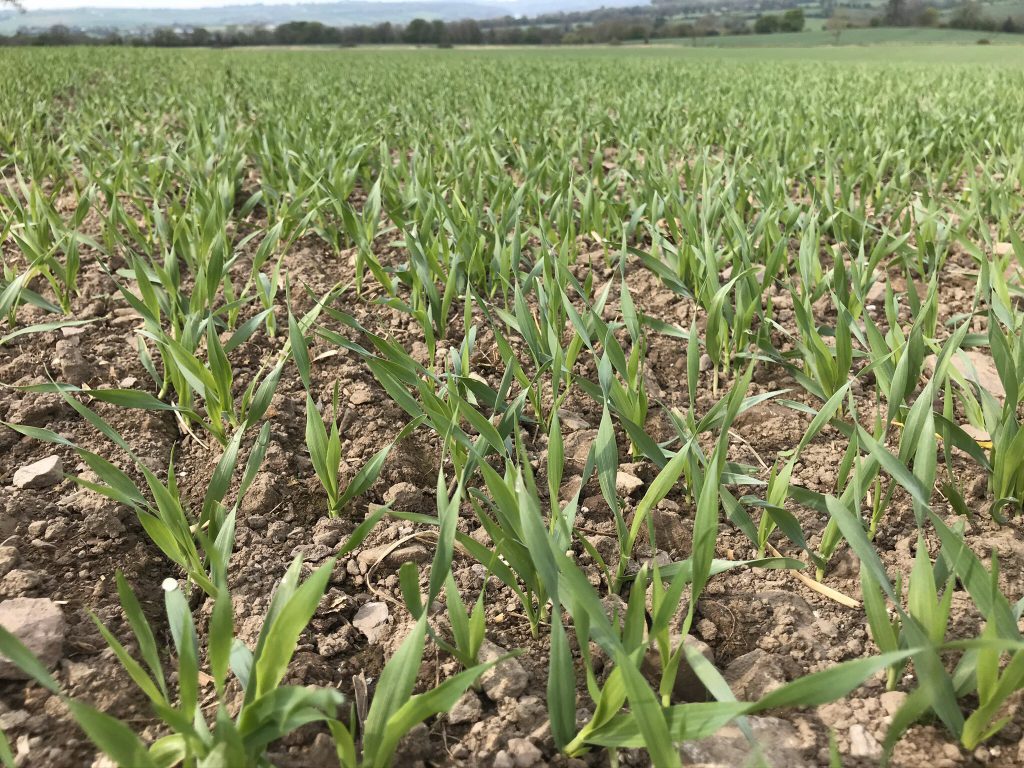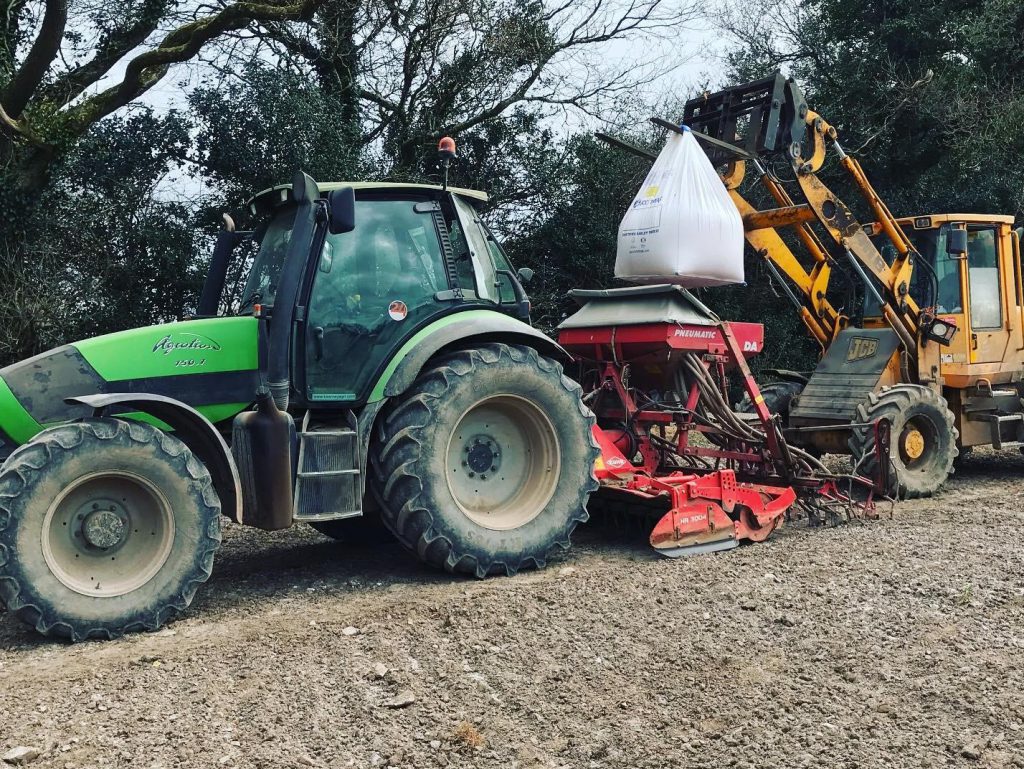Padraig Connery hails from Clashmore in Co. Waterford and farms between here and Villierstown. He has been farming full-time for almost six years now.
The mechanical engineer went back to study agricultural science in Waterford Institute of Technology (WIT) and sounds like he is relishing the challenge of tillage farming.
Throughout the conversation he shared with AgriLand, one word is used on numerous occasions – sustainability. He wants his farm to be sustainable and successful.
From the outside it seems like he has a pretty successful business already, employing a second labour unit on the farm, but he has more road to travel and is determined to keep investing in the business and make improvements. Each year he is taking steps forward and reaching his sustainability goals.
This week the rain was welcome. After a marathon month of work in April he was glad to see rain descend on the emerging crops and it also gave him time to catch up on paperwork – the BPS application was the job of the day when he took AgriLand‘s call.
“It was a chance to catch up on the office work. I take, on average, a day in the office every two weeks, but at this time of the year you mightn’t get a day for a month,” he noted.
So what’s been happening in the fields?
“On Saturday I sprayed all of the spring barley crops with an aphicide. We were going to go with the aphicide and weed spray together, but with the broken week coming we didn’t know when we were going to get in with the weed spray and there was no point leaving a window open for the aphids even though it was an extra run through the crop.
“The weed spray on the spring barley is next. Once the weather clears up at the end of the week we’ll go out. This is the third bout of rain it has got since it was sown so it has got plenty of moisture to drive up the weeds.”
Padraig added that while his malting barley has received all of its nitrogen (N) some of the spring barley destined for Irish distillers – grown for Denn Agri – has to receive its last split.
All of the spring barley carries some sort of premium with the malting barley grown for Boortmalt and Glanbia.
When asked about the announcement made by Boortmalt that its intake would be reduced this season, Padraig stated: “That’s a concern. We probably took a punt in this part of the country on Boortmalt. It seemed to be going pretty good.”
Padraig has a focus on premiums to bring in a sustainable income. Some of the winter barley is being grown for seed – Pixel – for Goldcrop and each year he grows 45-50ac of oats for Flahavan’s. This crop helps to form the outline of his rotation.
This is his first year growing Isabel oats. Last year’s crop of Husky did 3.9t/ac on good land.
Looking after the soil
The young farmer has an obvious passion for improving his soil quality.
“I’ve been trying to focus on the Ps and Ks [phosphorous and potassium]. There’s a piggery within four miles so we have an arrangement to get slurry.
I’ve been focusing on soil fertility and I reckon for every €6 I spent spreading pig slurry last year it was worth €10 to me.
He’s focused on improving indices and replacing what he’s taking away in crop production. Lime is also applied to half of the spring barley ground each year in the rotation.
Another way he is making his farm sustainable is by carrying out all of his own work. No contractors are hired in.
“We do all the work ourselves. We try to keep it a two-person operation, so rather than having 200ac of winter barley we have 100ac. We want to get our winter barley cut and baled and move on.”
This takes the pressure off at busy times of the year.
Padraig has invested in machinery over the past few years. Among the latest investments was an upgrade to the combine and the baler followed to keep up with the 21ft cut on the Deutz-Fahr 5690 HTS.
“We do a bit of contracting. We cut 150ac of spring barley on hire for neighbours. That’s why we’re 2:1 in winter crops, to try and get the combine freed up because the hire work is all spring barley.”
Padraig noted that the hire work pays for the upkeep of the combine.
With no break crops this year Padraig is looking at his options to try and bring a seed crop back into the rotation.
He has tried beans but not with great success on his land and maize has been on his mind, but as he says himself he doesn’t want to look at someone else cutting maize when he’s just invested in the combine. So he will continue to look for the crop that best suits his farm and rotation.
Experimenting with cover crops
Cover crops are something that he is experimenting with and again this comes back to his focus on soil health.
Last year Padraig planted with the one-pass and had mixed results so he’s researching sowing options at the moment and might alter the roller which he bought through the Targeted Agricultural Modernisation Scheme (TAMS) last year.
“I found the earthworm activity in those fields [with cover crops] was huge compared to the other fields when I was ploughing.
It’s definitely something I’m actively looking at; I want to find an efficient method of establishment.
Winter cereals
After a difficult winter Padraig is happy with his winter cereals.
The winter wheat is now due its T1, while the oats are due the second run of growth regulator and a fungicide application.
“We traditionally would have always grown two-row. Last year was my first year to grow six-row barley and this year I grew hybrid barley and the two-row is a good bit behind so I’m glad I experimented with it.”
He added that he is very open to information and suggestions which might improve his farming system. Padraig has both Bazooka and Belfry, while Pixel is being grown for seed.

The sun setting on a crop of spring barley after being rolled earlier in the month. Image source: Padraig Connery
Combine will be pulled out for maintenance
Looking into the coming weeks Padraig will be pulling out the silage gear. He finishes cattle on the farm and cut back numbers this year as a result of the poor prices. As well as producing silage for the home farm he also sells a lot of silage and hay so everything needs to be ready to go.
In the same vein he said he will pull out the combine in the coming weeks. While spring crops are only in the ground he is getting prepared, although he admits there shouldn’t be a lot to do with it.
Looking to the next investment Padraig may look at adding another furrow to the plough as in the wet autumn gone by he felt pressure to keep up with the seed drill.
This was also part of his reasoning for upgrading the combine. Weather windows are shorter and the job needs to be done as efficiently as possible.
He has no intention of moving away from the plough though. His late father John was involved in the ploughing association and the traditional method of establishment suits his land and produces good crops.
“The plough is the tried-and-trusted method,” he added.





